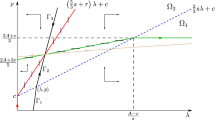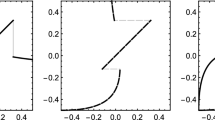Abstract
In this paper, the endogenous order of quantity decision is studied in a duopoly model with incomplete information. One firm knows the state of the demand curve while the other firm remains uninformed. Firms have to commit to a quantity in one out of two periods. While, a priori, simultaneous-move Cournot equilibria are possible, only Stackelberg equilibria, with either the informed or the uninformed firm moving first, emerge endogenously.
Similar content being viewed by others
References
Canoy, M. (1996): “Product Differentiation in a Bertrand-Edgeworth Duopoly”.Journal of Economic Theory 70: 158–179.
Cho, I.-K., and Kreps, D. M. (1987): “Signaling Games and Stable Equilibria”.Quarterly Journal of Economics 102: 179–221.
Daughety, A. F., and Reinganum, J. F. (1994): “Asymmetric Information Acquisition and Behavior in Role Choice Models: an Endogenously Generated Signaling Game”.International Economic Review 35: 795–819.
Deneckere, R. J., and Kovenock, D. (1992): “Price Leadership”.Review of Economic Studies 59: 143–162.
Eckhard, E. (1982): “Firm Market Share, Price Flexibility, and Imperfect Information”.Economic Inquiry 20: 388–392.
Furth, D., and Kovenock, D. (1992): “Price Leadership in a Duopoly with Capacity Constraints and Product Differentiation”.Journal of Economics/Zeitschrift für Nationalökonomie 57: 1–35.
Hamilton, J. H., and Slutsky, S. M. (1990): “Endogenous Timing in Duopoly Games: Stackelberg or Cournot Equilibria”.Games and Economic Behavior 2: 29–46.
Kohlberg, L., and Mertens, J. F. (1986): “On the Strategic Stability of Equilibria”.Econometrica 54: 179–221.
Kreps, D. M., and Wilson, R. (1982): “Sequential Equilibria”.Econometrica 50: 863–894.
Mailath, G. J. (1993): “Endogenous Sequencing of Firm Decisions”.Journal of Economic Theory 59: 169–182.
Ono, Y. (1982): “Price Leadership: a Theoretical Analysis”.Economica 49: 11–20.
Robson, A. J. (1990): “Stackelberg and Marshall”.American Economic Review 80: 69–82.
Schoonbeek, L. (1990): “Stackelberg Price Leadership in the Linear Heterogenous Duopoly”.Journal of Economics/Zeitschrift für Nationalökonomie 52: 167–175.
Stackelberg, H. v. (1934):Marktform und Gleichgewicht. Wien: Julius Springer.
Van Damme, E., and Hurkens, S. (1996a): “Commitment Robust Equilibria and Endogenous Timing”.Games and Economic Behavior 15: 290–311.
— (1996b): “Endogenous Stackelberg Leadership”. Working Paper Center for Economic Research 96115, Tilburg University, Tilburg.
Author information
Authors and Affiliations
Rights and permissions
About this article
Cite this article
Normann, HT. Endogenous Stackelberg equilibria with incomplete information. Journal of Economics Zeitschrift für Nationalökonomie 66, 177–187 (1997). https://doi.org/10.1007/BF01234405
Received:
Revised:
Issue Date:
DOI: https://doi.org/10.1007/BF01234405




